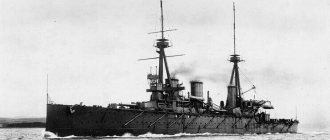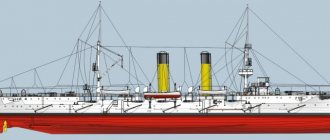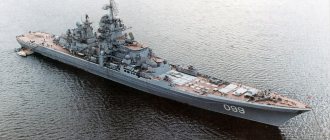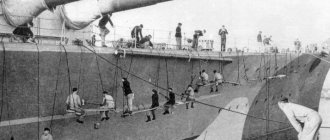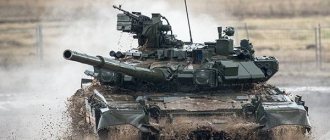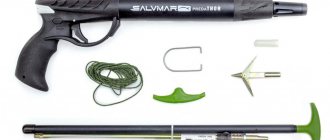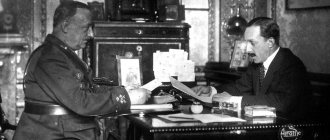Guards cruiser "Red Crimea"
Guards cruiser "Red Crimea"
The cruiser "Profintern" (future "Red Crimea") in Sevastopol, early 1930s.
Standard displacement is 6833 tons, full displacement is 7999 tons; length 158.4 m, width 15.36 m, draft 9.65 m, mechanical power (four turbines) 46,300 hp, maximum speed 22 knots, economic speed - 14 knots, cruising range 1200 miles. Armament (as of 1942): 15 - 130 mm, 6 - 100 mm (three twin Minisini installations), 4 - 45 mm and 10 - 37 mm guns, 7 - 12.7 mm machine guns, 2 three-tube 533 mm torpedo tubes. The cruiser could take on deck up to 90 mines, 10 large and 20 small depth charges. Reservations: side 25-75 mm, decks 20 mm, conning tower 75-125 mm, main battery gun shields - 25 mm. Crew 852 people.
On September 28 (October 11), 1913, the cruiser “Svetlana” was included in the list of ships of the Guards crew, and on November 24 (December 7) it was laid down at the Russian-Baltic Shipbuilding and Mechanical Plant in Revel. On November 28 (December 11), 1915, the cruiser was launched. In October 1917, the unfinished ship was towed to Petrograd. Since November 1924, the cruiser was completed at the Baltic Shipyard. Unlike the Red Caucasus, it was completed according to the original project with minor changes. On February 5, 1925, “Svetlana” was renamed “Profintern”. On July 1, 1928, the cruiser joined the MSBM.
The cruisers "Aurora" and "Profintern" in Swinemünde, 1929.
In August 1929, Profintern, together with the cruiser Aurora and four destroyers, took part in an overseas campaign, visiting the German port of Swinemünde. In November 1929 - January 1930, the cruiser Profintern (commander A.A. Kuznetsov), together with the battleship Paris Commune, made the transition around Europe from the Baltic to the Black Sea. The swim was very difficult. On November 22, 1929, the detachment left Kronstadt. The winter Atlantic greeted the ships with stormy weather, and in the Bay of Biscay they found themselves in a fierce, force 10 storm. The cruiser's roll reached 40°. The ships received heavy damage from the impacts of giant waves. They had to call twice at the French port of Brest for repairs. On January 18, 1930, the cruiser and battleship arrived in Sevastopol. In 57 days the ships covered 6269 miles.
"Profintern" was included in the MSCM. 1935–1938 The cruiser underwent a major overhaul and modernization at Sevmorzavod. On October 31, 1939, the cruiser was renamed, receiving the name “Red Crimea”.
Cruiser "Red Crimea", 1939
The cruiser met the beginning of the Great Patriotic War under the command of Captain 2nd Rank (then Captain 1st Rank) A.I. Zubkov. The ship was undergoing ongoing repairs at plant No. 201 (Sevmorzavod), which was completed on August 16.
On the morning of August 21, the “Red Crimea” with the destroyers “Frunze” and “Dzerzhinsky” left Sevastopol and arrived in Odessa exactly 24 hours later. The ships delivered more than 1,000 volunteer sailors and 120 tons of cargo. On August 23, the cruiser supported the defending troops, expending 462 130-mm shells. The cruiser repeatedly opened fire on planes bombing the Odessa port. In the evening of the same day, employees of the Odessa Bank and 60 bags of money were taken onto the cruiser. Having completed loading, the "Red Crimea" went to sea and arrived in Sevastopol at 7.30 on August 24.
"Red Crimea" took part in the landing at Grigoryevka near Odessa. On September 21, in the Cossack Bay of Sevastopol, two battalions of the 3rd Marine Regiment - 1109 people - were accepted onto the ship. At 13.38 he weighed anchor and, entering the wake of the Red Caucasus, headed to the landing area as part of a detachment. On September 22 at 1.14 the detachment arrived in the Grigoryevka area. The cruiser occupied the starting point, and, without giving up the anchor, holding on by the machines, opened fire on the shore. At 1.40 a.m. the landing began using barges. Supporting the landing, “Red Crimea” fired with its entire board at Chebanka, the state farm named after. Kotovsky, Bourgeois. By 3.00 the barges had transported 416 people, then the gunboat “Red Georgia” approached the cruiser and received the remaining paratroopers. At 3.43, the cruiser stopped firing along the shore, firing 273 130-mm and 250 - 45-mm shells. Then the cruisers headed to Sevastopol.
On October 2, “Red Crimea” delivered a machine-gun battalion from Batumi to Feodosia.
On October 30, “Red Crimea” arrived in Sevastopol, delivering a battalion of marines from Novorossiysk - 600 people with weapons and ammunition. On the night of October 31, enemy aircraft raided the main base, the cruiser commander ordered not to open anti-aircraft fire, so as not to unmask the ship.
On November 2, at 9.30, a fierce air raid on Sevastopol began; three Ju-88s attacked the cruiser, dropping seven bombs. They all fell 20 m from the side, five Red Navy men were wounded by shrapnel. On November 3, “Red Crimea”, having received 350 wounded, 75 military personnel, 100 evacuees, documents from the Black Sea Fleet headquarters, left Sevastopol at 18.27, and on November 6 at 14.00 it arrived in Batumi.
On November 9, the cruiser arrived from Batumi to Sevastopol. On November 10, “Red Crimea” carried out three fires with its main caliber: at a long-range enemy battery in the Kachi area (81 rounds), at an accumulation of enemy manpower in the Inkerman area (31 rounds), and at the area of the village of Duvankoy (20 shells). German aviation carried out a massive raid on Sevastopol, and the cruiser shot down an enemy plane with 45-mm gun fire.
On November 11, the first offensive of German troops against Sevastopol began. On this day, "Red Crimea" continued to fire at enemy infantry concentrations, firing 105 shells. On November 12, “Red Crimea” stood by the refrigerator. At 10.00 a strong raid on the city and ships began, the cruiser opened fire with all anti-aircraft guns and machine guns. Two groups of three Ju-88 aircraft entered the ship and dropped bombs from level flight. 10 bombs fell at a distance of 50 m and further. The same planes attacked the cruiser twice more, but due to intense anti-aircraft fire, they dropped bombs inaccurately, and the ship did not receive any damage. At 12.00, the second wave of 28 bombers attacked the city and ships, the cruiser Chervona Ukraine was seriously damaged and died, and the destroyers Besposhchadny and Sovershchenny received heavy damage. Enemy planes visited the Red Crimea several times, but bombed inaccurately, and the ship did not receive any damage. On this day, while repelling air attacks, 221 100-mm and 497 45-mm shells were expended. On November 13 and 14, German planes bombed the South Bay and ships, but strong anti-aircraft fire each time forced them to hastily drop bombs; the cruiser did not receive any damage.
On November 14 at 23.15, the ship, having received 350 wounded, 217 military personnel, 103 civilians, 105 tons of cargo, left Sevastopol. At dawn, he joined the guard of the Tashkent transport. On November 17, the cruiser arrived in Tuapse at 16.30.
On the morning of November 28, the "Red Crimea", accompanied by the destroyer "Zheleznyakov", arrived in Sevastopol, delivering 1000 soldiers and reinforcement commanders from Novorossiysk for the Primorsky Army. On November 29, December 1, 2 and 3, the cruiser carried out 11 firing missions at concentrations of enemy troops. On November 29, the ship spent 179, on December 1 - 149, on December 2 - 99, on December 3 - 28 shells. The shooting at the village of Mamasai on December 1 was carried out at the maximum distance - 120 kbt, so an artificial roll of 3° to the left side was created.
On December 5, having received 296 wounded and 72 evacuated passengers, the Red Crimea left Sevastopol at 16.20. On the morning of December 6, he joined the guard of two transports. The next day the ship arrived in Tuapse, where it unloaded some of the wounded and evacuees, and on December 9 it moved from Tuapse to Poti.
"Red Crimea" on a military campaign.
On the morning of December 10, the cruiser left Poti, escorting the Kalinin and Dimitrov transports with troops for Sevastopol. On December 13 at 8.00 the ships turned to the Inkerman target, at this time the enemy opened fire, several shells landed 50–70 m from the cruiser, two sailors were wounded by shrapnel. In the evening of the same day, the cruiser left Sevastopol for Novorossiysk, where it arrived at 6.00 on December 14.
On December 17, the enemy launched a second attack on Sevastopol along the entire front. Headquarters ordered the immediate delivery of reinforcements to the city’s defenders. On December 20, having received 1,680 soldiers and commanders of the 79th Special Rifle Brigade, at 17.00 “Red Crimea”, as part of a detachment of ships, left Novorossiysk. Because of the fog, the detachment could not cross the minefields at night, and was forced to break through to Sevastopol during the day on December 21. In the area of the Khersones lighthouse, the ships were attacked by German aircraft - six Me-110s, 6 bombs were dropped on the cruiser, falling 100 m astern, while the planes fired at the ships with machine guns. “Red Crimea” did not receive any damage; its anti-aircraft artillery actively repelled the attacks. At 13.00 the ships entered the main base, the cruiser moored at the refrigerator and began disembarking. In the evening, “Red Crimea” fired at a motorized convoy near the village of Alsu, expending 30 shells.
On December 22, the cruiser conducted four firings during the day and expended 141 shells. At 19.30, having received the wounded, the cruiser, accompanied by the destroyer Nezamozhnik, left Sevastopol for the Balaklava area. Having stopped its progress and guided by the lights lit on the shore, the cruiser fired at enemy positions.
Having finished firing (77 shells were fired), the ships headed to Tuapse, where they arrived on the morning of December 23.
"Red Crimea" took part in the Kerch-Feodosia operation. At the first stage of the operation, the cruiser was included in the naval support detachment of the landing detachment “B”, which was supposed to land at Mount Opuk. On December 25 at 20.20, the “Red Crimea” with the destroyer “Shaumyan” left Novorossiysk for the Kerch Strait area. On the night of December 26, the cruiser shelled the port of Feodosia, firing 70 shells. Then the ships maneuvered aimlessly in the Gulf of Feodosia, awaiting the approach of the landing force. At 6.00 on December 27, a message was received that the landing detachment had not left Anapa. The cruiser returned to Novorossiysk.
"Red Crimea" was included in the detachment of ships supporting landing detachment "A". On December 28, the cruiser received a landing party - 2,000 soldiers and commanders of the 9th Rifle Corps, 2 mortars, 35 tons of ammunition, 18 tons of food. The ship housed the commander of the 9th Rifle Corps, Major General I.F. Dashichev with his staff. At 19.00, the "Red Crimea" left the moorings and, as part of a detachment with the cruiser "Red Caucasus" and three destroyers, left Novorossiysk.
On December 29, at 3.45, the naval support detachment laid down on a combat tack, and three minutes later, the “Red Crimea” opened fire on the port side from 130 mm and 45 mm guns. At 4.03 the fire ceased, and at 4.35 the cruiser anchored 2 kbt from the Shirokiy Mole and began landing with the help of four barges, then six patrol boats arrived, which transported 1,100 paratroopers. Later, the “Shield” BTSC came aboard the cruiser and received 300 people.
The enemy fired from guns, mortars and machine guns at the motionless ship; it was under artillery and mortar fire for more than two hours. At 9.15 the landing of the paratroopers was completed (Major General I.F. Dashichev and his headquarters remained on the ship) and the cruiser weighed anchor.
During the landing, the ship was hit by 8 shells and 3 mines, it received two holes in the sides and many small holes in the deckhouses, superstructures and pipes, and two fires broke out. The holes were sealed and the fires were quickly extinguished. Three 130-mm guns were disabled, 18 people from the crew and landing party were killed and 46 were wounded.
Covering the landing, the ship fired direct fire at enemy firing points and concentrations of troops in the port and city, in the area of Cape Ilya. Two batteries were destroyed, one was suppressed. The cruiser expended 318 130 mm and 680 45 mm shells.
In the morning, German air raids began. The cruiser was attacked 11 times, but only in three cases did bombs land 10–15 m from the ship. Bomb fragments made 50 small holes. At night, "Red Crimea" anchored.
The cruiser "Red Crimea" under enemy bombs, 1942
On the afternoon of December 30, the ship maneuvered in the Gulf of Feodosia, repelling air raids. At 16.00 in Dvuyakornaya Bay, Major General Dashicheva and his headquarters were transferred to a minesweeper. After this, the cruiser left for Tuapse, where it arrived on the morning of December 31.
On January 1, 1942, “Red Crimea”, having received 260 people and 40 tons of cargo, left Tuapse for Feodosia at 17.00. On January 2 at 15.00 he anchored 3.5 kbt from the protective pier of the Feodosia port and began unloading personnel and cargo. At the same time, the cruiser supported the troops near Feodosia with gun fire. On January 2 and 3, the cruiser maneuvered in the Feodosia Gulf. The weather conditions continued to deteriorate: strong swell, snow, fog. On the morning of January 4, the ship, completely covered in ice, returned to Novorossiysk.
On January 4 and 5, "Red Crimea", together with a minesweeper and four boats of the Ministry of Defense, twice tried to land troops in the Alushta area. But, due to icing of the boats, the detachment returned to Novorossiysk. On January 8, “Red Crimea” delivered 730 soldiers and commanders and 45 tons of cargo from Novorossiysk to Feodosia.
In January 1942, the Black Sea Fleet, in order to divert enemy forces advancing on Feodosia, landed three tactical landings in the Sudak area, in two of them - on January 15 and 25 - "Red Crimea" participated.
On January 15, having received the landing - 560 soldiers and commanders of the 226th mountain rifle regiment, "Red Crimea", under the flag of the commander of the landing ship detachment, captain 1st rank V.A. Andreeva, at 13.00 with the destroyers Soobrazitelny and Shaumyan left Novorossiysk. At 22.10 the detachment approached Sudak, the ships took up positions and opened fire on the coastline in the landing area. The enemy's wire barriers and firing points were destroyed. At 1 o'clock on January 16, the cruiser dropped anchor and began landing troops and unloading ammunition with boats and barges. Covering the landing, the cruiser periodically opened fire on Sudak. The cruiser was fired at from the shore by mortars, but the ship was not hit. At 4.15 the landing was completed, the cruiser pulled anchor and set out on a retreat course. At 16.25 he arrived in Novorossiysk.
"Red Crimea" transfers troops to Sevastopol, March 1942.
On the night of January 25, the “Red Crimea”, carrying 1,450 Red Army soldiers and commanders of the 554th Mountain Rifle Regiment, 70 tons of ammunition, 10 tons of provisions, approached the Sudak area with the destroyer “Shaumyan”. In rough sea conditions, the landing of troops by longboats and SKA boats began. By 6.00 on January 25, the landing was basically completed - 1,300 people, all ammunition and food were unloaded, 250 people remained on the ship. But the increased excitement and the proximity of dawn did not allow the ships to remain off the coast. They weighed anchor and headed to Novorossiysk.
On February 14, the cruiser delivered 1075 marching companies and 35 tons of cargo to Sevastopol. On February 19, the writer and marine painter Leonid Sobolev visited the ship. On February 22, anchored in Sevastopol Bay, the Red Crimea fired at enemy troops in the Shuli area. On February 24 at 11.40 the cruiser was attacked by seven Ju-88s. The cruiser's anti-aircraft gunners opened fire in a timely manner. The planes took turns diving onto the ship, and each dropped two 500 kg bombs. Three fell on the left side at a distance of 20 m, 11 - on the starboard side at a distance of 10 m or more. The ship was filled with mud and covered in smoke and dust, but it received no damage. At 19.27, the cruiser with the destroyer "Shaumyan" left Sevastopol and arrived in Tuapse at noon on February 25. A company of marines was loaded onto the cruiser - 250 people and 25 tons of cargo, and on the same day it delivered it to Novorossiysk.
Rally on board the Red Crimea, 1942
On the morning of February 27, "Red Crimea", accompanied by the destroyer "Shaumyan", arrived in Sevastopol. The ship delivered the 674th artillery anti-tank regiment from Novorossiysk: 500 soldiers and commanders, 20 76-mm guns, 20 tons of ammunition. On February 28, while at anchor, the Red Crimea fired 60 rounds to suppress two German batteries. With the onset of darkness, the cruiser with the destroyers “Shaumyan” and “Zheleznyakov” left Sevastopol for the Alushta area to provide fire support for the demonstration landing. On the night of February 29, the cruiser opened fire on the coastline and Alushta. The enemy responded, but to no avail. The minesweepers and patrol boats were never able to land troops. On the afternoon of March 1, the cruiser maneuvered at sea, and at 18.00, by order of the fleet commander, she left for Poti.
The offensive of the Crimean Front troops ended unsuccessfully, and German troops went on the offensive. During this period, the fleet command increased military transportation to Sevastopol. On March 11, the Red Crimea, guarded by the destroyer Svobodny, delivered 180 tons of shells and mines from Poti to Sevastopol. Having unloaded ammunition, the cruiser, escorted by the destroyer "Shaumyan", left Sevastopol on the same day, having on board 246 wounded and four bodies of 305-mm guns for the battleship "Paris Commune" (total weight 208 tons). On the evening of March 12, the ships arrived in Poti.
On March 16, 165 tons of ammunition, 20 tons of food, 150 barrage balloons, and 293 soldiers and commanders were loaded onto the ship. At 17.40, the cruiser with the destroyer Nezamozhnik left Poti for Sevastopol, escorting the tankers Sergo and Peredovik. On March 18, the convoy was attacked 11 times by bombers and 1 time by torpedo bombers. The ships fired intense anti-aircraft fire. A total of 50 bombs were dropped on ships and transports, but not a single one hit the target. On March 19 at 1.30 the ship arrived in Sevastopol, where four barrels of 305-mm guns were loaded onto it. At 20.30, the cruiser left Sevastopol for Poti with the destroyer Nezamozhnik.
Stern guns of the cruiser "Red Crimea", 1943
Almost continuous trips at full speed throughout the year affected the condition of the mechanisms. From March 25 to April 23, 1942, the cruiser was repaired in Batumi.
From April 24 to May 1, "Red Crimea" made two flights to Sevastopol, delivered 130 tons of ammunition, 2,500 reinforcements, and removed 90 wounded and 100 evacuees. During transitions and while parked at the main base, he repelled German air raids.
In total, during the period from June 22, 1941 to May 1, 1942, “Red Crimea” used 1,336 100-mm and 2,288 45-mm shells when repelling air attacks.
On May 8, the enemy launched an attack on Sevastopol. The Commander-in-Chief of the North Caucasus direction ordered the fleet commander: “...The cruiser “Red Crimea”, after loading with two destroyers, no later than May 10, leave Novorossiysk for Sevastopol...”. On the afternoon of May 11, the cruiser with the destroyers “Dzerzhinsky” and “Nezamozhnik” left Poti and on the morning of May 12 arrived in Novorossiysk. Having accepted reinforcements for the Primorsky Army, they left for Sevastopol at 20.00. On May 13, in fog, the ships followed along the Anatolian coast, and then turned north and approached the entrance point of the fairway. At midnight they stopped the cars until visibility improved. Only at 19.50 on May 14, “Red Crimea” entered the main base, delivering 2,000 soldiers and commanders and 80 tons of ammunition. Due to thick fog, the cruiser, like other ships that arrived in Sevastopol, could not leave the bay until May 19. On May 19–20, the cruiser, having received 473 wounded with the destroyer Nezamozhnik, moved from Sevastopol to Tuapse, and then to Poti.
"Red Crimea" in Poti, 1943
On June 2, "Red Crimea", having received marching companies, weapons, ammunition and food, accompanied by the destroyers "Soobrazitelny" and "Svobodny", left Novorossiysk and on the night of June 3 broke through to Sevastopol. On June 4, having received 275 wounded and 1,998 evacuees, the ships left Sevastopol at 2.00 and arrived in Tuapse on the morning of June 5.
In 1942, the Red Crimea was more often than other ships of the squadron involved in transporting military reinforcements and cargo to blockaded Sevastopol - from February to May it broke into the main base seven times.
For courageous and decisive actions during the landing of troops in Grigoryevka, Feodosia and Sudak, for the courage and heroism of the personnel shown in the fight against the Nazi invaders, on June 18, 1942, by order of the People's Commissar of the Navy No. 137, the crew of the cruiser "Red Crimea" was awarded the Guards ranks.
"Red Crimea" in Poti, August 1943
On June 22, “Red Crimea” moved from Poti to Tuapse for another trip to Sevastopol. However, it had already become clear to the fleet command that the cruisers would not be able to break into the besieged city.
On July 26, Navy Day, Rear Admiral N.E. Basisty handed the guards flag to the ship. The flag was accepted by the ship's commander, Captain 1st Rank A.I. Zubkov.
At the end of July 1942, German troops went on the offensive in the North Caucasus. There was a threat of a breakthrough of the 17th German Army to the Black Sea in the Novorossiysk area. The evacuation of the city began. From August 5 to 17, “Red Crimea” made four flights, delivering evacuees and valuable cargo from Novorossiysk to Batumi, and to Tuapse, units of the 32nd Guards Rifle Division.
Between August 28 and October 6, 1942, the cruiser underwent ongoing repairs.
In mid-October 1942, enemy troops went on the offensive in the Tuapse area. On October 21, the Red Crimea with the destroyers Besposhchadny and Soobrazitelny delivered 3,350 soldiers, 11 guns and 47 mortars from Poti to Tuapse. On December 2, the Red Crimea, accompanied by the destroyer Nezamozhnik, delivered units of the 9th Mountain Rifle Division from Batumi to Tuapse.
"Red Crimea" at the head of the fleet enters Sevastopol, November 1944
G.
"Red Crimea" took part in the landing operation in the South Ozereyka area, as part of a cover detachment. On the morning of February 3, 1943, the detachment left Batumi and moved west to disorient the enemy, and then turned to the area of operation. On February 4 at 2.16 the detachment approached the landing area and set out on a combat course. At 2.35 "Red Crimea" opened fire on Ozereyka. Having expended 598 130-mm and 200 100-mm shells, the ship ceased fire at 3.05. Having finished shelling the shore, the cruiser set out on a retreat course. On February 5 at 10.50 "Red Crimea" arrived in Batumi.
In April 1944 A.I. Zubkov was appointed commander of the cruiser Murmansk, loyal to the United States for reparations. Captain 1st Rank P.A. becomes the commander of “Red Crimea”. Melnikov.
From May 15 to August 17, 1944, the cruiser underwent scheduled repairs in Poti. In this case, the method of incomplete docking was used in a 5000-ton dock. The length of the ship's bow console was 33.6 m, the trim angle of the floating dock was 3°. The cruiser, which was in dock, was visited by the People's Commissar of the Navy, Admiral N.G. Kuznetsov.
"Red Crimea" in the Southern Bay of Sevastopol, 1944
In November 1944, the Black Sea Fleet squadron relocated to Sevastopol. On November 4 at 9.00, the cruiser left Poti along with the battleship Sevastopol, guarded by five destroyers and 8 “big hunters” boats. On November 5 at 8.00 the ships joined the second detachment - two cruisers and three destroyers. At 8.50 the signal was raised on the flagship for “Red Crimea” to be the lead.” The cruiser went around the battleship at full speed and became the head of the squadron. At 12.50, the cruiser's bow 100-mm mount fired the first salute shot; she was the first of the squadron ships to enter the base and at 13.07 stood on her barrel.
During the Great Patriotic War, "Red Crimea" participated in almost all operations of the Black Sea Fleet and made more cruises than other cruisers. However, during all this time she did not receive a single heavy damage comparable to the damage to other cruisers of both the Black Sea and Baltic fleets. Perhaps this was the result of military luck, but most likely the skill of the commander and the excellent training of the entire crew of the ship.
The ship completed 58 combat missions, carried out 52 artillery fire on enemy positions, suppressed 4 artillery and mortar batteries and destroyed 3 ammunition depots and up to 3 infantry battalions, repelled 205 attacks by enemy aircraft (one plane was shot down), transported over 20 thousand military personnel, wounded and evacuated citizens.
"Red Crimea" at the parade in Sevastopol, 1947
On April 8, 1953, "Red Crimea" was withdrawn from combat service and reclassified as a training cruiser. On May 7, 1957, the cruiser was disarmed and reorganized into the OS, and from March 11, 1958 into the PKZ. On July 7, 1959, the ship was removed from the lists of the fleet.
Service history[edit]
When Svetlana
towed from Tallinn to St. Petersburg in November 1917, she was approximately 90% complete and the Soviets expected to enter service in 1919, but she was left unfinished due to the disruptions of the Russian Civil War.
[1] It was not until November 1924 that work resumed on her and she was renamed Profinterna
(Russian: Profintern) on 5 February 1925. She was completed in October 1926, but she had to return to the docks to corrected numerous problems and was not put into service until July 1, 1928.[2]
"Profintern"
was completed almost to its original design, but was modified to control aircraft by adding cranes on either side of the middle funnel, and a parking area was built for them between the center and rear funnels, although catapults were never installed. Her original internal torpedo tubes were replaced by two triple 450 mm (18 in) torpedo tubes mounted on the deck aft of the stern funnel. [3] and her original four 38-caliber 2.5-inch (64 mm) anti-aircraft guns were replaced with nine 30-caliber 3-inch (76 mm) Lender anti-aircraft guns. [1]
Initially based in the Baltic, she was transferred to the Black Sea Fleet in 1929, arriving there on 18 January 1930 with the battleship Paris Commune. At the end of the 1930s, it was overhauled, aircraft equipment was removed from it and equipped with new fire control equipment. The ship received three Italian twin Minizini
100 mm (3.9 in) 47 caliber, one was placed on the forecastle in front of the forward 130 mm (5.1 in) B7 Pattern 1913 gun, and the other two on the forecastle.
on each side of the quarterdeck. Four single mounts for the 45 mm 21-Kbyli semi-automatic gun are installed, as well as seven 12.7 mm (0.50 in) anti-aircraft machine guns. At some point, she swapped her 21-K
guns for a naval version of the M1939 (61-K) 37 mm automatic air defense gun.
On October 31, 1939, Profintern
was renamed
Krasny Krym
[4].
Hit Perekop along the shortest route
Having received Moscow's approval, the headquarters of the Transcaucasian Front developed a more detailed plan of operation. It took into account the replacement of the 56th Army, transferred to the Southern Front, with the 44th Army, which was transferred from Dagestan. At the same time, the question of encircling the Germans on the Kerch Peninsula had not yet been raised and there was no talk of landing on Feodosia.
The plan was fully formed when the General Staff involved sailors in preparing the operation. The commander of the Black Sea Fleet and head of the Sevastopol defensive region, Vice Admiral Philip Oktyabrsky, proposed expanding the landing bridgeheads by adding Feodosia to Kerch.
"Comrade Stalin does not object"
The idea of conducting a landing operation to liberate the Kerch Peninsula was born at the headquarters of the Transcaucasian Front. On November 26, 1941, the front commander, General Dmitry Kozlov, presented his views to the Chief of the General Staff of the Red Army, Marshal Boris Shaposhnikov.
Commander of the Caucasian Front, General Dmitry Kozlov
The report stated that with the help of the Black Sea Fleet and the Azov military flotilla, seven to eight rifle divisions from the 51st and 56th armies, three to four artillery regiments and three to four tank battalions could be delivered to the eastern coast of the Kerch Peninsula - to the area of Cape Khroni and the Kazaulsky lighthouse - with the simultaneous release of 700-900 paratroopers.
In the future it was planned to advance in the direction of Feodosia and Tulumchak. Kozlov asked for seven to ten days to prepare the operation. The document emphasized:
The purpose of the action is to prevent the withdrawal of enemy troops from Crimea and weaken his offensive on Sevastopol
Thus, the headquarters of the Transcaucasian Front wanted to take revenge for the abandonment of Kerch on November 16, 1941 by units of the 51st Army.
As for Sevastopol, the attempt of the 11th German Army under the command of General Erich von Manstein to take the city on the move, made from November 11 to 21, did not bring results: the Primorsky Army of General Ivan Petrov, which was transferred from Odessa, repulsed the onslaught. At the same time, the parties were preparing for decisive battles.
The Headquarters of the Supreme High Command reacted favorably to Kozlov's initiative, which fit well into the general situation on the fronts: on November 29, 1941, Rostov-on-Don was recaptured, on December 5-6, a strategic counteroffensive began near Moscow, on December 9, Tikhvin was liberated in the Leningrad region.
A few days later, Kozlov received a call from General Alexander Vasilevsky, who, due to Shaposhnikov’s illness, was temporarily acting as chief of the General Staff of the Red Army. He said: “Comrade Stalin considers your proposal to carry out the Kerch operation expedient. It will bind the enemy’s forces in Crimea and will significantly help Sevastopol.”
Notes[edit]
- ^ B from "Cruiser Red Cream" (in Russian). Retrieved July 23, 2009. CS1 maint: discouraged parameter (link)
- Jump up
↑ Conway's, p. 208 - Jump up
↑ Breyer, pp. 117, 165 - Breuer, page 165
- Rover, pp. 97, 100, 102
- Rover, page 105
- Rover, pp. 111-2, 114-5, 120
- Rover, pp. 122, 128
- Rover, pp. 129, 136, 138
- Rover, pp. 143, 146, 149-50, 161, 164, 166, 169-70
- Wheatley, page 209
- Rover, pp. 186, 188-9
- Rover, pp. 194, 204, 216
- Rover, page 229
- Rover, page 280
Street combat tactics of assault groups
The total crew losses on December 29 were 23 dead and 66 wounded. “Red Crimea” got a little less. As a result of 11 hits, 12 sailors were killed and 26 were wounded. This did not prevent about 5,400 people from the first drop from landing in Feodosia. On the night of December 30, regiments of the 236th Infantry Division of General Vasily Moroz began to arrive in the city, constituting the first echelon of the main invasion forces.
The paratroopers, hiding behind the massive brick fence of the port, quickly infiltrated the city. The attackers’ task was made easier by the fact that there were no local residents in the houses, whom the Nazis had evicted long ago.
Hero of the Soviet Union Alexander Altunin, who commanded a rifle company, spoke about the actions of his subordinates in his memoirs:
First, we smoked the Nazis out of a squat building whose windows overlooked the square, then we surrounded a two-story house in the courtyard. It is unlikely that we would have managed to do without losses if not for Lieutenant Ukraintsev, who threw grenades surprisingly accurately. He took advantage of the fact that we concentrated fire on the windows, turned around the corner with lightning speed and threw two grenades into the windows one after another, and with the third he knocked down the wooden door
While still on the ship, Altunin created assault groups in his platoons, which included, in addition to machine gunners and machine gunners, a sapper with a supply of explosives and a fighter with a backpack flamethrower. Later, this tactic of urban combat would be adopted by the defenders of Stalingrad, clearing the enemy house by house.
Hero of the Soviet Union General Alexander Altunin
The attackers did not linger near the small houses where the enemy was holed up; the sailors had to finish them off; the main task was to quickly break through to Bald Mountain, rising north-west of Feodosia.
The confusion that engulfed the German garrison also played into their hands. Colonel Behringer, the senior commander of the 11th Army in terms of rank and position in the city, received orders from Manstein’s headquarters to defend every quarter, but acted in his own way.
Believing that sappers in an unfamiliar settlement would inevitably fall into a trap, the colonel withdrew the 46th sapper battalion along with construction companies from Feodosia, ordering them to take positions on Bald Mountain and at the fork in the highway to Simferopol and Dzhankoy. However, the sappers were soon surrounded and forced to retreat; they were joined by artillerymen who abandoned their guns in the city.
Storm and attempts to drop troops into the sea
The results of the first day of the operation were unclear for both sides. Late in the evening of December 26, the commander of the Kerch naval base, Rear Admiral Alexander Frolov, and the military commissar of the base, Valerian Martynov, went to the Taman pier to make an informed decision: to suspend the landing or continue it.
Martynov later recalled:
By midnight, the first echelon of troops loaded onto the ships and awaited the signal to sail. The night was quite bright, the moon was visible through the sparse clouds. It was snowing. And a real storm broke out in the strait, the air temperature dropped to 8-10 degrees below zero. Now, if only the berths on the other side had already been captured... And so only a few will overcome the strip of coastal storm surf, and even in the cold
The sailors came to the conclusion that in such weather conditions the landing party had to give up. The next day did not bring any changes: the raging storm did not allow new troops to be transported. The headquarters of the Transcaucasian Front tried to challenge the arguments of the naval specialists, but after studying the situation, they were forced to agree with their opinion. The operation was resumed only on December 28.
Meanwhile, the German command tried to drop troops into the sea, primarily on the northern coast of the Kerch Peninsula. The Germans deployed two battalions against Colonel Leontyev’s detachment. The opponents launched brutal counterattacks several times, but the balance of forces was not in favor of the Soviet soldiers, who, having lost three tanks in the battle, retreated to the shore.
In the area south of Kerch, the dug-in paratroopers were actively supported by long-range artillery fire from the Taman Peninsula. However, here the Germans strengthened their positions by transferring infantry and artillery units. Therefore, an attempt to expand the captured territory near Kamysh-Burun, on which units of the Soviet 827th Mountain Rifle Regiment landed on December 28, did not lead to success.
On the night of December 29, 1941, the commander of the Transcaucasian Front (the next day the front was renamed the Caucasian Front) reported to the General Staff of the Red Army that the situation at the front of the 51st Army “was not in our favor.” All bridgeheads were blocked by the enemy, for whom their destruction was only a matter of time.
Sevastopol will last only three days
But the start of the operation had to be postponed - on December 17, the 11th German Army launched the second assault on Sevastopol. Its divisions launched an offensive along the shortest route - in the direction of the Belbek River valley, wanting to break through to the Northern Bay. Thus, Manstein tore the Soviet front into two parts, cutting off parts of the fourth sector of defense from the rest of the troops. A diversionary strike was carried out along the Chernaya River towards Inkerman.
Oktyabrsky’s deputy for land defense of Sevastopol, Rear Admiral Gavriil Zhukov, on the evening of December 19, informed Headquarters about the critical situation:
Losses in two days of battle reach 3,000 wounded, many losses in command personnel. Large losses of materiel, guns, machine guns, mortars. Most of the heavy coastal defense batteries have been suppressed. Troops along almost the entire front retreated to the second line. Reserves, replenishment are used up
Zhukov warned Moscow that if the enemy continued to advance at the same pace, the garrison of the main base of the Black Sea Fleet would not last even three days. The besieged city urgently needed reinforcements.
On the same day, a meeting was held in Novorossiysk at the reserve command post of the Black Sea Fleet on the details of the upcoming landing operation.
In addition to the leadership of the fleet, commanders and commissars of detachments of ships and transports were also present. Oktyabrsky was listening attentively to the speakers, when suddenly the cipher clerk of the fleet headquarters entered and placed a cipher message form in front of the vice admiral.
Commander of the Black Sea Fleet Filipp Oktyabrsky
After reading it several times, the commander frowned and, interrupting the meeting, said to his officers: “The operation is postponed for now. We will inform you about the new dates. Continue preparations. You now have the opportunity to think through a lot of things without such a rush.”
The naval commanders returned from the reserve command post in silence, somewhat discouraged.
In the coded message, the Headquarters placed responsibility for the fate of Sevastopol on the command of the Transcaucasian Front, demanding that at least one rifle division and one brigade be transferred to Crimea. Oktyabrsky was personally ordered to immediately leave for Sevastopol and lead the defense.
Links[edit]
- Roger Chenault, ed. (1980). Conway's Fighting Ships of the World 1922–1946
. Greenwich: Conway Maritime Press. ISBN 0-85177-146-7. - Rover, Jurgen (2005). Chronology of War at Sea 1939–1945: A Naval History of the Second World War
(Third Revised Edition). Annapolis, MD: Naval Institute Press. ISBN 1-59114-119-2. - Whitley, M. J. (1995). Cruisers of World War II: An International Encyclopedia
. London: Cassell. ISBN 1-86019-874-0.
First Kerch, and then Feodosia
The 345th division of Colonel Nikolai Guz, the 79th naval rifle brigade under the command of Colonel Alexei Potapov and the 125th separate tank battalion were sent to help the Sevastopol residents.
The formations immediately entered the battle with artillery support from warships. This slightly weakened the German pressure in Sevastopol and postponed the landing operation for almost a week.
Moreover, instead of the prepared and trained units that were supposed to go in the first wave of landing, the 44th Army received the 63rd Mountain Rifle Division, whose fighters had little understanding of amphibious assault. In addition, the division's strength was significantly smaller and its artillery weaker. Of the rifle units, only the 105th Mountain Rifle Regiment underwent airborne training.
It was decided to space the landings over time - first to land troops around Kerch, and when the ships and transports of the Black Sea Fleet were freed, already in Feodosia
On the evening of December 23, Shaposhnikov approved this decision.
At the headquarters of the 11th Army, they admitted the possibility of an enemy landing, but did not have exact data - in order to maintain military secrets, all Soviet troops preparing for the operation were informed about the transfer to Sevastopol and learned about the real target only at sea.
A column of German soldiers on the street of Kerch during the parade, November 27, 1941
Photo: Nationaal Archief
The Wehrmacht could oppose the Red Army on the Kerch Peninsula with the 42nd Army Corps of General Hans von Sponeck, which included only the 46th Infantry Division under the command of General Kurt Himer. Manstein withdrew the 170th Infantry Division for the assault on Sevastopol. Romanian units were used mainly for rear guard and anti-partisan operations.
